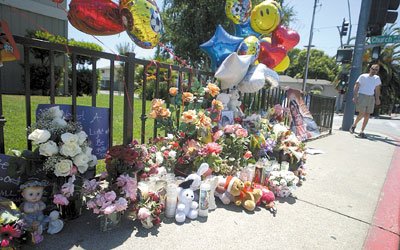Memorials to honor those killed in accidents placed throughout
South County
By Rachelle Gines Staff Writer
Gilroy – Complete with flowers, balloons, candles and religious figures, a number of roadside memorials have sprung up in honor of those killed in accidents in South County this year.
A small memorial with rocks shaped in a cross was erected in honor of Jose Juan Pacheco Figueroa the day after he was killed when his horse caused him to collide with a utility pole Saturday. Almost a month after 5-year old Brayan Trejo was killed in June by a car while in a crosswalk, stuffed animals have replaced the fresh flowers that surrounded the small boys picture.
A number of questions have sprung up about the memorials as well. What is the purpose of them? Why are they maintained so diligently? How long are they kept up?
Questions about the memorial aside, traffic and safety issues have arisen due to the high visibility of the memorials on well traveled roads. What are the laws regulating public memorials?
In Morgan Hill, a memorial was erected to honor 20-year-old Nicholas Schindler, who died in June after he was killed allegedly after racing another driver.
And, almost half a year later, family and friends are still placing flowers at a memorial by Railroad and San Pedro avenues after 18-year-old Jackie Gamboa died when a train struck the car she was riding in after her the driver – her boyfriend – tried to cross the railroad tracks in Morgan Hill.
Cultural context
Gilroy resident Rebeca Armendariz, 31, said Hispanics view death differently than most Americans.
“Death is not seen as something scary or evil,” Armendariz said. “Of course death is sad, but it’s not so much mournful. These shrines are a way to celebrate someone’s life.”
Armendariz works for the United Service Employee International Union, a labor union for workers in Santa Clara County. She explained that the significance of memorial shrines could be traced back to traditions from ancient Mexican tribes.
“It goes back to our indigenous heritage. When warriors died, some were buried with weapons, some other people might be buried with their cooking utensils,” Armendariz said. “It’s just whatever they might need to continue on with their journey.”
The example of the buried warrior Armendariz said, explains why people might have left items like coloring books, crayons, toys and candy at 5-year-old Brayan Trejo’s grave.
“It’s still his spirit, and those are still things he likes … it’s a way to remember them … sometimes we spoil our dead,” Armendariz said.
While driving in Mexico, Armendariz said that memorial shrines there are so common, that she has seen them street after street.
“It’s so traditional in Mexico, you’ll see four or five crosses on one block alone,” Armendariz said.
Saul Gonzalez, 24, of Gilroy, agreed with Armendariz. He is the community outreach specialist for the Glen View Alliance for Neighbors Achieving Success, GANAS, a non-profit organization of five local agencies that target families with children younger than 5.
“The shrines are a place to be with our loved ones. They’re coming back to visit us, we’re going to visit them,” Gonzalez, who was born in the Mexican state of Jalisco, said.
Gonzalez used the example of the popular recording artist Selena, the slain Tejano singer who was gunned down and killed in 1995 by the president of her fan club in Texas.
“There were memorials all over the state of Texas,” Gonzalez said drawing the similarity of the community’s reaction to Brayan’s Trejo’s case, but noting it was on a smaller and local level.
Even if people did not know the victim of a tragedy, Gonzalez said memorials allow people to show their care and concern for the person and their family. As far as the maintenance of memorials and how long they are kept up, Gonzalez said, that families are aware that they cannot keep shrines indefinitely.
“People understand that memorials are only temporary. People will stop being so attentive, and we’re aware that we can’t keep them up forever,” Gonzalez said.
Armendariz said the maintenance of the memorial is dependent on the family.
“There’s no set norm for maintaining memorials, especially with a child,” Armendariz said. “It’s whatever the family is comfortable with.”
For safety’s sake
The highly visible memorials to Trejo on 10th and Church streets, as well as the other memorials throughout South County have raised some concerns among residents wondering whether the colorful posters and balloons may cause drivers to become distracted, creating a traffic hazard.
California Highway Patrol officer Grant Bowles said that the high visibility of similar memorials on state highways and freeways are a cause for concern, and that private memorials are not allowed on state highways.
“We don’t want people slowing down to look at the memorials, and we don’t want people getting out of their cars because they might get hit by cars passing by,” Bowles said.
Bowles said that memorials on county roads may be allowed, but only if owners of private property along the road allow it. He also added that if drunk driving is involved in a death, families might be able to contact Caltrans, so that a mandated sign up might be posted warning people not to drink and drive in memory of the deceased person.
“We try to understand what people are going through. But the law is the law,” Bowles said, explaining that the CHP uses private land to erect memorials to officers killed in the line of duty. “It applies to us also.”
Caltrans, Bowles said, is usually the agency responsible for taking down unsanctioned memorials. Bowles said even though a law in place, agencies try to be sensitive to the situations.
Within Gilroy, Scott Barron, code enforcement officer for the city, said that officials are sympathetic to families who erect memorials, and guidelines for memorials are not specifically addressed in city codes.
“There are no set policies or guidelines for memorials,” Barron said, adding that he is not aware of any complaints concerning the current memorials in the city. “But if it becomes a public safety issue, then the city would look into it.”
Gilroy Police Department Sgt. Kurt Svardal also said that as far as memorials are concerned, public safety is the number one issue. He said Trejo’s memorial rests on a fence along private property, and doesn’t obstruct the sidewalk, raising no issue with the department.
Saul Gonzalez also said people should be aware of what they are doing when they drive by a memorial.
“I understand that safety is an issue, but people should exercise common sense. If they want to see a memorial, they should park their car in a safe place and walk to it if it’s not on a highway,” Gonzalez said. “Aren’t billboards just as, if not more, distracting than a memorial?”














